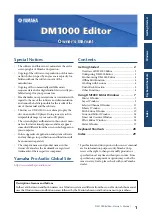
Additional APWeb Info for Network Admin
27
APWeb Instruction Manual
Additional APWeb Info for Network Admin
This chapter contains information on embedding the XBar applet (see below) and on changing the proxy
setting (see page 28).
Embedding the XBar Applet
The XBar applet can be embedded in a custom website by using the applet tag shown below.
Make any of the following adjustments to the code to fit your particular system’s requirements.
Replace the code base value with the IP address for your system if it is different than the
default IP address.
Set the width and height for the display based on the initial virtual matrix size (smaller VMs
look fine in a smaller size, while larger VMs require a larger size to minimize scrolling).
Optional – Specify the
"InitialVM"
value, or the lowest numbered VM will display by default.
Optional – Include the
"VMLockDown"
information if you want to limit control to a
particular virtual matrix; otherwise, all virtual matrices will be accessible from the VM title
block. Specify
"locked"
or
"unlocked"
for the value. The XBar defaults to the unlocked state
if this option is not included in the tag.
Optional – Specify the
"AllowGain"
value, if you want the input gain adjustment feature
enabled. Specify
"true"
for the value.
Optional – Specify the
"AllowVolume"
value, if you want the output volume adjustment
feature enabled. Specify
"true"
for the value.
Important:
If you do not want either or both of the “Allow Gain” and “Allow Volume” options, omit
those parameter(s) entirely.
XBar Applet Tag
<HTML>
<BODY>
<!-- Your custom html code goes here. -->
<APPLET code="CrossBar.class" codebase="http://192.168.0.251"
archive="CrossBar.jar" width=400 height=500 >
<param name = "InitialVM" value = "0">
<param name = "VMLockDown" value = "locked">
<param name = "AllowGain" value = "true">
<param name = "AllowVolume" value = "true">
</APPLET>
</BODY>
</HTML>





































